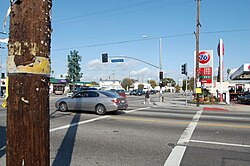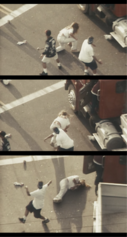Attack on Reginald Denny
| Part of 1992 Los Angeles riots | |
 | |
| Date | April 29, 1992 |
|---|---|
| Time | 6:46 pm |
| Location | Los Angeles, California, U.S. |
| Coordinates | 33°58′28″N 118°18′01″W / 33.974577°N 118.300285°W |
| Target | Reginald Denny |
Reginald Oliver Denny (born 1953) is a former construction truck driver who was pulled from his truck and severely beaten during the 1992 Los Angeles riots. His attackers, a group of black men who came to be known as the "L.A. Four", targeted Denny because he was white. The attack was captured on video by a news helicopter and broadcast live on U.S. national television.
Four other black L.A. residents who had witnessed the attack on live television came to Denny's aid, placing him back in his truck and driving him to the hospital. Denny suffered a fractured skull and impairment of his speech and his ability to walk, for which he underwent years of rehabilitative therapy. After unsuccessfully suing the City of Los Angeles, Denny moved to Arizona, where he worked as an independent boat mechanic and has mostly avoided media contact.
Background
On March 3, 1991, an amateur video recording showed Rodney King, a black motorist, being badly beaten by Los Angeles Police Department officers during an arrest. The outrage resulting from the acquittal of these police officers was the principal cause of the 1992 Los Angeles riots.[1]
Born in 1953 in Lansing, Michigan,[2][1] Reginald Oliver Denny was a 39-year-old truck driver at the time of the attack.[3] His parents moved to Sylmar, Los Angeles, when he was a child.[4]
Attack

On April 29, 1992, at 5:39 p.m., Denny loaded his red
In what has been called an "iconic image" of the L.A. riots, video footage from the
Antoine Miller climbed up and opened the truck door, giving an unidentified man the chance to pull Denny out and throw him on the ground. Henry Watson stood on Denny's neck to hold him down as a group of men surrounded him and Anthony Brown kicked him in the abdomen.
Four black residents of
The "L.A. Four"
The "L.A. Four" was a nickname given to the first four men charged with the attack on Denny: Damian Williams, Henry Watson, Antoine Miller, and Gary Williams.[17]
Damian Monroe Williams (born March 17, 1973) was considered the most high-profile member of the four.
Henry Keith Watson was a 27-year-old former US Marine and ex-convict who had served time for armed robbery. After his release from prison, he married, had a daughter, and was working two jobs at the time of the attack.[19]
Antoine Eugene Miller (May 5, 1972 – February 8, 2004) was a 19-year-old who lived with Damian Williams' family. Miller's mother was not able to care for him, so as a child, Miller was sent to live with his grandmother. When he was 12, his grandmother killed his grandfather during an argument and was convicted of his murder, leaving Miller homeless. Miller had previously been arrested for misdemeanor drug charges, joyriding, and failing to appear in court.[19] Miller was shot and killed at age 31 in a Hollywood nightclub in February 2004.[20]
Gary Anthony Williams was a 33-year-old man described as a "drifter" and a "hustler" who begged at a local gas station. Although he claimed to work there, his arrest record listed him as unemployed.[19]
Trials
On May 12, outgoing
Judge John W. Ouderkirk granted Miller a separate trial on the grounds that the strong evidence against Watson and Damian Williams could harm his case; Miller was sentenced to 17 months in jail and 27 months on probation.[23] Gary Williams was sentenced to three years in jail for attempting to rob Denny and assaulting another man.[24]
Edi M.O. Faal was Damian Williams' defense attorney, and Earl C. Broadly was Henry Watson's. On July 28, 1993, Watson's and Williams' trial began. The two were charged with the assault of Denny as well as five other motorists and two firefighters who were driving past the intersection of Florence and Normandie shortly after the start of the Los Angeles riots on April 29. At the trial, Denny faced his attackers for the first time since they had assaulted him. On August 12, 1993, a jury of five whites, three blacks, three latinos, and one asian was chosen.[citation needed]
On August 19, Deputy District Attorney Lawrence Morrison delivered the opening statement and a week later, the videotape of the beating was shown. The doctors who treated Denny testified, describing his wounds and their efforts to repair them. Next to testify were witnesses of the beating and Denny's rescuers. The prosecution rested on September 17, 1993. The defense began pleading on September 20, making a case for unpremeditated assault, with Faal challenging the video evidence and portraying Williams as a victim of poverty and racism. In the closing arguments, the defense attorneys claimed that Williams and Watson were being used as scapegoats for the L.A. riots. The prosecution counter-argued that the two had knowingly tried to kill Denny and were not victims.[15]
Williams' lawyers successfully argued that he had not intended to kill Denny;[18] he was found not guilty of attempted murder, assault, and aggravated mayhem, and convicted of four misdemeanors and simple mayhem, while Watson was convicted of a single misdemeanor assault charge.[11] During a break in the trial, Denny approached Williams' mother, Georgiana, and hugged her.[2] Watson was given credit for time served and was sentenced to three years' probation for the assaults of Denny and truck driver Larry Tarvin. Williams was denied bail and sentenced to a maximum of ten years for the assaults of Denny and four other people on December 7, 1993.[25]
Aftermath
Denny sought to soothe racial tensions associated with his assault, reminding reporters that most of his rescuers were black, as were the doctors who treated him.
As a result of the injuries he suffered during the attacks, Denny had to undergo years of rehabilitative therapy, and his speech and ability to walk were also damaged.[2][12] During his recovery, he received over 27,000 get-well cards from supportive members of the community.[27] After unsuccessfully suing the city of Los Angeles, Denny moved to Arizona to work as an independent boat motor mechanic. Denny has largely avoided the media and rarely spoken publicly about his ordeal.[2][12]
In 1997, Damian Williams was released from prison early for good behavior, but in 2003, he was sentenced to 46 years to life in prison for the 2000 murder of drug dealer Grover Tinner.
Related litigation
The best available footage of Denny's beating on April 29, 1992, was filmed by Marika Tur from a helicopter piloted by her then-spouse, reporter Zoey Tur. Together, they operated a company called Los Angeles News Service (LANS).
LANS sued television stations that rebroadcast their footage for copyright infringement; at least one of these lawsuits was successful.[31]
In July 2006, LANS sued the site
Explanatory notes
- ^ Then known as Bob Tur.
References
- ^ ISBN 978-1-4144-3274-8– via Encyclopedia.com.
- ^ ISBN 978-1-59884-222-7.
- ^ ISBN 978-1-101-21346-9.
- ^ a b c d e Sipchen, Bob (December 24, 1992). "Denny--Beaten but Unbowed". Los Angeles Times.
- ^ ISBN 978-1-59884-222-7.
- ^ Jennings, Angel; Hamilton, Matt (April 25, 2017). "At the corner of Florence and Normandie, marking causes of L.A. riots". Los Angeles Times.
- ISBN 978-0-8153-1982-5.
Although undoubtedly some of these hate crimes involved white victims (consider the highly publicized case of Reginald Denny who was dragged from his truck by five African American men and severely beaten after the acquittal of Los Angeles police officers charged with beating Rodney King)...
- ^ McLaughlin, K. A.; Malloy, S. M.; Brilliant, K. J.; Lang, C.; et al. (February 2000). Responding to Hate Crime: A Multidisciplinary Curriculum For Law Enforcement and Victim Assistance Professionals (PDF). Newton, Mass.: National Center for Hate Crime Prevention, Education Development Center, Inc. Archived from the original (PDF) on January 10, 2017.
During the 1992 riots in Los Angeles, following the acquittal of Los Angeles police officers in the videotaped beating of Rodney King, a group of young black males dragged white truck driver Reginald Denny from the cab of his truck and severely beat him within an inch of his life. This attack has been described as a retaliatory hate crime that occurred in response to the police brutality against Rodney King, and to widespread public perception that the justice system had failed to protect King's civil rights.
- ^ ISBN 978-1-57356-973-6.
- ISBN 978-1-4516-4110-3.
- ^ ISBN 978-1-59884-222-7.
- ^ a b c d Gray, Madison (April 27, 2007). "The L.A. Riots: 15 Years After Rodney King: Key Figures: Reginald Denny". Time. New York.
- ^ Sastry, Anjuli; Bates, Karen Grigsby (April 26, 2017). "When LA Erupted In Anger: A Look Back At The Rodney King Riots". NPR.
- ^ Gray, Madison (April 27, 2007). "The L.A. Riots: 15 Years After Rodney King: Key Figures: Bobby Green". Time.
- ^ ISBN 978-1-4987-0414-4.
- ^ Boyer, Edward J. (August 27, 1993). "Rescuers Describe Saving Beaten and Bloody Denny". Los Angeles Times.
- ^ a b Curry, Fatima; Fancis, Enjoli (April 28, 2017). "'Let It Fall': 'L.A. Four' member speaks about life lessons, 25 years after riots". ABC News.
- ^ a b c Singal, Jesse (April 27, 2007). "The L.A. Riots: 15 Years After Rodney King: Key Figures: Damian Williams". Time.
- ^ a b c Newton, Jim (May 25, 1992). "Denny Suspects Are Thugs to Some, Heroes to Others". Los Angeles Times.
- ^ Rogers, John (April 26, 2017). "A look at prominent figures in 1992 riot, where they are now". Associated Press.
- ^ "Four arrested in televised riot beating". UPI. May 12, 1992.
I wanted very much to personally arrest him, Gates said of the man suspected of hurling a brick at Denny's head April 29. I did that all by myself with the aid of about 200 police officers.
- ^ "Four Arrested in Beating of Trucker During Riots". Sun Sentinel. May 13, 1992.
- ^ a b Blankstein, Andrew (February 12, 2004). "Man Guilty in '92 Denny Attack Dies". Los Angeles Times.
- ^ "Man sentenced to three years in Denny case". UPI. March 26, 1993.
- ^ Boyer, Edward J.; Ford, Andrea (December 8, 1993). "Williams Given Maximum 10 Years in Denny Beating". Los Angeles Times.
- ^ a b c Gray, Madison (April 27, 2007). "The L.A. Riots: 15 Years After Rodney King: Key Figures: Henry Keith Watson". Time.
- ^ Harris, Mark (April 27, 2012). "2002 Interview: Reginald Denny Looks Back on the LA Riots, Get-Well Cards". KNBC.
- ^ Munoz, Hilda (May 3, 2003). "Figure in '92 Riots Convicted of Murder". Los Angeles Times.
- ^ Jordan, Billie (April 29, 2017). "25 Years After L.A. Riots Damian 'Football' Williams Reflects On His Life And Role In The Rebellion". Eurweb.com.
- ^ "Let It Fall: Los Angeles 1982-1992 | About". ABC Entertainment. Retrieved March 4, 2024.
- ^ Stim, Rich (n.d.). "Summaries of Fair Use Cases". Stanford Copyright and Fair Use Center. Stanford University. Retrieved March 4, 2024.
- ^ "Tur v. YouTube, Inc., No. 07-56683 (9th Cir. 2009)" (PDF). Law.justia.com. Retrieved March 4, 2024.
